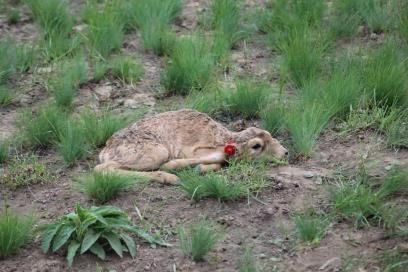Speaking Saigas
Nothing comes close to experiencing the beauty of Saigas roaming their vast habitat. A close second is perhaps sharing their stories and gaining valuable feedback ensuring the work my colleagues and I do is robust and meaningful.

Being a lucky recipient of the SCA-bursary to attend the Society of Conservation Biology-(SCB) Asia conference in Bishkek during early August 2018 provided one such opportunity. The conference’s agenda was conservation in changing Asia. Asia is a dynamic continent, with economic changes happening here multitudes faster than most other continents. This along with realities of climate change and increased human mobility results in a melting pot of diversity and opportunity.
Disease ecology has seen a paucity of research in Asia. New diseases are emerging here at rates faster than ever before, yet our understanding of it is not only limited but highly reactive as well. Saigas are a species that exemplify this (sadly!) more than any other species.
The 2015 mass die off in Kazakhstan that killed more than 200,000 individuals was driven by climate stressors, whereas the 2016 mass off in Mongolia which wiped out nearly 2/3rd of the Mongolia sub-species was attributed to a novel disease in the country (petit-peste de ruminant) attributed to spill over from livestock.
Different entities are chiselling away at Saiga research and conservation in their last remaining habitats of the world. Be it the Association for Conservation of Biodiversity of Kazakhstan (ACBK) in Kazakhstan or Wildlife Conservation Society (WCS-Mongolia) in Mongolia (just to name a couple), researchers and conservationists alike have dedicated their lives to the cause of Saigas. Perhaps a little unfortunately, these entities work somewhat in isolation, often out of necessity rather than want.
SCB-Asia, however, provided us (some parts of the global saiga researcher unit) with a platform to come together and not only network but share our work with the larger academic society. I was fortunate enough to be a part of the symposium lead by Dr. Buuviebaatar Bayaarbataar (Buuvie) from WCS-Mongolia that aimed at informing the audience of ungulate health in Central Asia.
Dr. Bayaarbataar opened the symposium by taking about the diversity of ungulates that inhabit the Central Asia region, and the new emerging disease threats to their existence. Following this, Steffen Zuther from ACBK gave the audience an in-depth understanding of the causes behind the mass die-off of Saigas in Kazakhstan from 2015. Needless to say the audience was stunned by the realization that climatic triggers can cause such catastrophic events.
WCS-Mongolia’s director Enkhtuvhshin Shiilegdamba then spoke about the events in Mongolia with the Mongolian saiga, stressing on how it is important that proactive disease management and surveillance measure be taken to ensure that disease (especially new and emerging ones) don’t spill over from livestock to wild species.
I, then followed up by talking about my hope, through my PhD, to build a disease transmission model that will help delimit transmission hotspots between livestock and saigas. My proposition was that once we understand these hotspots we can then work with local stakeholders such as livestock herder to improve livestock health using cost effective methods. This is socio-economically important for the herders and can help limit disease transmission to Saigas.
To wrap up the symposium, we also had talks from other members of WCS on some proactive disease surveillance that has restricted disease spill over from livestock to wild mountain ungulates in Afghanistan and how the Mongolia gazelle were victims of disease transmission (for the Foot and Mouth virus) from livestock rather than being the transmitters, as was previously believed.

As the symposium grew to a close to various inquisitive questions addressed to us speakers, not only did it provide the audience with an increased awareness of the urgency of disease in the context of ungulates of Central Asia, but it also convinced them (hopefully, anyways) that rather than just reacting to disease events, it is important that we deal with them proactively, so as to minimize losses of precious wildlife in the future.
As I sat down with my colleagues post-conference, sipping a cup of freshly brewed tea, my heart was content that at least a few of us “saiga researchers” found a common time and space to talk saigas and disease to a larger audience. Synergy and collaboration is the best conservation intervention, perhaps?
